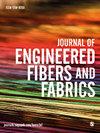Principle capabilities of crocheted fabrics for composite materials
IF 2.3
4区 工程技术
Q1 MATERIALS SCIENCE, TEXTILES
引用次数: 0
Abstract
A first limited approach for the automated production of crocheted fabrics was introduced in 2019. However, the knowledge on crocheted fabrics is very scarce and only few technical applications are presented in the literature. To provide a basis for possible future technical applications, the general tensile properties of crocheted fabrics are explored, and a promising application as composite reinforcement is introduced. Due to the early development state of the crochet machine prototype, conventionally hand-made crocheted fabrics are studied and the benefit of improving the machine is evaluated. The mechanical properties of crocheted fabrics depend significantly on the individual crocheter, but fabrics produced from the same person are sufficiently reproducible for reasonable investigations. Anisotropic properties with a trend toward higher resisted forces in course compared to wale direction were identified with crochets constructed from single crochet (sc) and from half double crochet (hdc) stitches. Furthermore, a tendency toward higher possible loads at larger elongations was revealed for crocheted fabrics compared to knitted ones. To the best of our knowledge, for the first time crocheted aramid fabrics were used in epoxy composites. With a crocheted reinforcement in a non-cut composite produced by vacuum-assisted hand lay-up, significantly higher ultimate tensile strength and Young’s modulus were recorded compared to a knitted one with comparable fracture modes.复合材料用钩针织物的基本性能
2019年推出了第一种有限的钩针织物自动化生产方法。然而,关于钩针织物的知识是非常稀缺的,只有少数技术应用是在文献中提出的。探讨了钩针织物的一般拉伸性能,并介绍了其作为复合增强材料的应用前景,为今后可能的技术应用提供了基础。由于钩针机样机的发展状况尚不成熟,对传统手工钩针织物进行了研究,并对改进钩针机的效益进行了评价。钩针织物的机械性能在很大程度上取决于单个钩针编织者,但同一个人生产的织物具有足够的可重复性,可以进行合理的研究。单钩针(sc)和半双钩针(hdc)编织的钩针的各向异性性能与纵向相比,具有更高的阻力趋势。此外,与针织织物相比,钩针织物在较大伸长时可能承受的载荷更高。据我们所知,这是第一次在环氧复合材料中使用钩针芳纶织物。与具有类似断裂模式的针织增强材料相比,在真空辅助手工铺设的非切割复合材料中使用钩编增强材料,记录了更高的极限拉伸强度和杨氏模量。
本文章由计算机程序翻译,如有差异,请以英文原文为准。
求助全文
约1分钟内获得全文
求助全文
来源期刊

Journal of Engineered Fibers and Fabrics
工程技术-材料科学:纺织
CiteScore
5.00
自引率
6.90%
发文量
41
审稿时长
4 months
期刊介绍:
Journal of Engineered Fibers and Fabrics is a peer-reviewed, open access journal which aims to facilitate the rapid and wide dissemination of research in the engineering of textiles, clothing and fiber based structures.
 求助内容:
求助内容: 应助结果提醒方式:
应助结果提醒方式:


